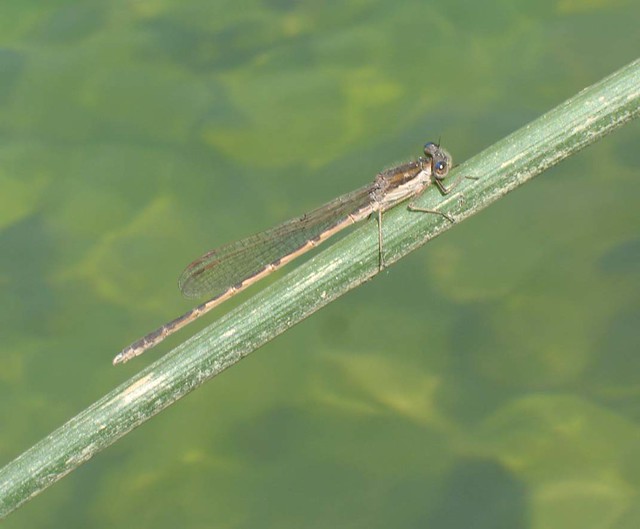Sympecma fusca
Cladus: Eukaryota
Supergroup: Opisthokonta
Regnum: Animalia
Subregnum: Eumetazoa
Cladus: Bilateria
Cladus: Nephrozoa
Cladus: Protostomia
Cladus: Ecdysozoa
Phylum: Arthropoda
Subphylum: Hexapoda
Classis: Insecta
Subclassis: Pterygota
Division: Palaeoptera
Ordo: Odonata
Subordo: Zygoptera
Superfamilia: Lestoidea
Familia: Lestidae
Subfamilia: Sympecmatinae
Genus: Sympecma
Species: Sympecma fusca
Name
Sympecma fusca (Vander Linden, 1820)
Synonyms
Agrion fusca Vander Linden, 1820
Sympecma aragonensis Navás, 1927
References
Links
IUCN link: Sympecma fusca (Least Concern)
Vernacular names
Polski: straszka pospolita, zimówka rudawa
The Common Winter Damselfly, Sympecma fusca, is a damselfly that is found in much of central and southern Europe. It does not have the bright blue or red colouration that is more usual for damselflies so it is often overlooked. It is one of only two species of European dragonflies that overwinter as adult insects, the other being the related S. paedisca. It is a member of the Lestidae and related to the emeralds or spreadwings.
Description
Although related to the Lestes 'spreadwing' damselflies, Sympecma rest with their wings alongside their bodies and do not have the metallic emerald green sheen that is characteristic of the Lestes. Sympecma have pale brown pterostigma on both forewing and hindwing and the pterostigma are nearer the wing tip on the forewing which means that both pterostigma can be seen — they do not overlap as in other damselflies. In the field this is easily seen and distinguishes Sympecma from all other damselflies. S. fusca is a nondescript damselfly that blends in with the dried grass stalks in which it overwinters but it is distinct from all other European damselflies except S. paedisca, so in most of its range there are no problems with identification. Where both S. fusca and S. paedisca fly together careful examination of the adult, in the hand, preferably under magnification, is required to tell the two species apart. In the male the anal appendages are slightly different and there are subtle differences in the markings on the thorax in both sexes.
Behaviour
This species is found all year round as it overwinter as an adult. In spring they mates and with the pairs still in tandem, the females oviposit in floating vegetation. Most reproductive behaviour occurs in April and May. The eggs hatch and the larvae develop rapidly in about 2 months. When the adults emerge they move away from water, often to heath or grassland a long distance from water, where they overwinter hidden amongst dried plant stems.
Habitat and distribution
It is found much of central Europe stretching out to Asia where it is replaced by S. paedisca. It is found around the Mediterranean in Europe and North Africa and on many Mediterranean islands. It can be found in all types of standing water. In winter adults are found away from water on dry plant stems usually in open areas such as grassland and heaths. It was recorded for the first time in Britain in 2008.[1]
Lestes parvidens
References
Askew, R.R. (2004) The Dragonflies of Europe. (revised ed.) Harley Books. pp65–66ISBN 0946589755
d'Aguilar, J., Dommanget, JL., and Prechac, R. (1986) A field guide to the Dragonflies of Britain, Europe and North Africa. Collins. ISBN 0002194368
Gibbons, R.B., (1986). Dragonflies and Damselflies of Britain and Northern Europe. Country Life Books. ISBN 0600358410.
Dijkstra, K-D.B & Lewington, R. (2006) Field Guide to the Dragonflies of Britain and Europe. British Wildlife Publishing. ISBN 0953139948.
Notes
^ "Winter Damselfly". British Dragonfly Society. Retrieved 6 June 2011.
Retrieved from "http://en.wikipedia.org/"
All text is available under the terms of the GNU Free Documentation License


